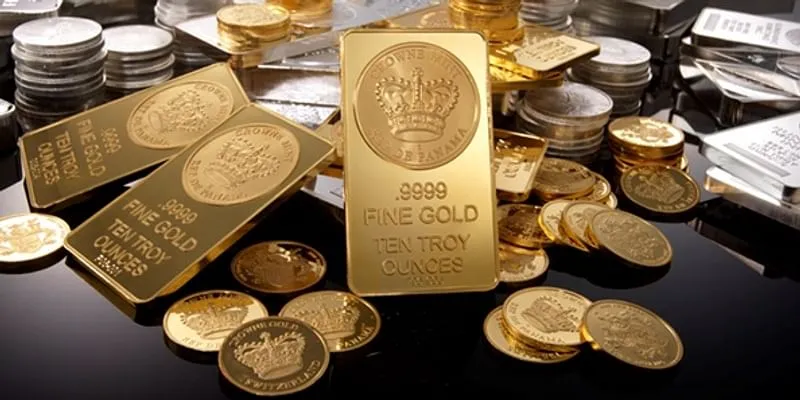Why Paytm’s Deepak Abbot and Nitin Misra relooked at the $1.5T gold assets that Indians own
Founded by Deepak Abbot and Nitin Misra, indiagold is a Delhi-NCR based digital gold startup that provides consumers with digital gold, gold loans, and digital locker facilities at their doorstep.
Digital gold or gold loans weren’t segments former Paytm executives Nitin Misra and Deepak Abbot wanted to explore. The duo, who created several financial products and were building the digital loan segment for Paytm, didn’t think it would be a viable business.
But soon, in 2020, the duo ended up founding indiagold, a startup operating in the digital gold lock and locker segment.

That very year, the gold-based lending platform raised an initial seed round of Rs 14 crore from Leo Capital, Blume Founders Fund, Sequoia Scout and seven angels. It also confirmed a $12 million fundraise from PayU and Alpha Wave Incubation Fund, along with others like Better Tomorrow Ventures, 3one4 Capital, and Rainmatter Capital.
Indiagold offers users the option to store gold in lockers at much cheaper rates than banks, and also proffers a credit line for the deposited gold. As of June this year, indiagold had sold gold worth Rs 4 crore, customers can store gold and earn close to six percent interest annually on the value of the deposit and it already has over 800,000 customers across Delhi-NCR.
The case for digital gold
The founders’ early reluctance wasn’t based on market size. In fact, just based on market size, gold loans would be a great segment to start up as, according to the World Gold Council, Indians sit on a $1.5 trillion hoard of gold.
Amid the pandemic, the market for gold loans is significantly increasing. The World Gold Council expects the market to grow at an annual rate of 15.7 percent and reach Rs 4.617 trillion in the fiscal year ending March 2022.
The numbers look tempting, but there are barriers.
“Gold as an asset class in India has strong emotional values and connotations associated with it. Someone taking a gold loan needs to trust in the brand, as it would be handling a precious, high value asset. There’s another obstacle: the stigma associated with gold loans,” Nitin says.
The duo realised this was a market with both online and offline plays. It was a large market, but they were unsure of cracking the space and were contemplating the launch of a hyperlocal tech company.
“We were talking to one of the partners we used to work with at Paytm for digital gold. And we realised that there was something there. We spent the next few months drilling down the case - understanding what gold is and what it means to different socio-economic classes,” Nitin says.
Working to crack the market
Market research and multiple conversations crystallised their plan: gold monetisation. This meant a variety of products, beginning with doorstep gold loans.
In India, gold loans have traditionally been done through bank branches or NBFCs like Muthoot Finance. The doorstep gold loans was a new category, focused on riding the growth of internet users and their rising trust.
“In lending, especially unsecured lending, the lender has to trust the consumer. In gold loans, the customer has to trust you. That’s the reason brands like Mannapuram Gold and Muthoot Finance have built their business over several decades,” Nitin says.
Existing gold loan players have a good density in terms of branch network, but it isn’t easy to get a gold loan. Consumers often end up going to local money lenders and paying higher amounts.
About 127,000 bank branches in India and 40,000 to 50,000 NBFC branches offer the gold loan facility.
“Not more than 20-25 percent of branches of banks and NBFCs give gold loans. There are exceptions to this, South Indian banks like CSB, KVB, SIB, and Federal Bank, but not among national players,” he says.
Making the asset work better
Deepak says companies like Muthoot Finance and Mannapuram Gold are valued based on the AUM or assets under management.
“That's one single metric that shows that how efficient they are. So, just like in every field where startups come in, we looked at are they serving the customer well, or are there any operational inefficiencies that can be plugged?”
He adds the new gold loan model may look like moving the branch to the doorstep, but the idea isn’t to build an asset-heavy model. Tech was tapped to look at every aspect of a loan book and see where time and processes could be reduced so that the OPEX to AUM ratio reduces, and adds to the top and bottom line.
Deepak says, “Today my most important unit is the loan manager, the person who actually goes to people's house and onboards customers. The idea is to get this person to do more number of loans in a day. This replaces the cost of a branch. If this person does let's say one loan a day of one lakh, that’s a monthly Rs 30 lakh. Can I increase this to Rs 2.5 or Rs 3 crore a month?”
He adds that at a physical branch - it costs Rs 38 lakhs to get a book size of Rs 10 crore, while indiagold spends 1/6th of the same amount to get a book size of Rs 10 crore.
The next step is to simplify the KYC processes while ensuring security.
“After the loan is disbursed, the focus is on giving the customer multiple payment options. How do we help the end consumer plan their payments, when can they close the loan, renew it, and ask for more. This happens seamlessly using our core loan management system,” Deepak says.
“Our is a heavy capital asset. Insurance is key, but we also need to ensure the safe movement of the product. Our app has a geofencing and tracking layer that allows the movement of the gold - from the customer's house to bank branches – to be trailed.”
The team is trying to build a computer vision model, where the loan officers get a business app that lets them complete processes, including clicking pictures, and a machine learning algorithm that can show a confidence score on the purity of the gold.

Focusing on digital gold
The founders had plans to build the product and partnerships in March, but everything was upended by the pandemic.
“We had an amazing team that kept on building from home. In July 2020, we launched our first product, Digital Gold, which is similar to what Paytm, PhonePe, Google Pay, and many players offer. That was our mouth of the funnel product,” Nitin says.
The duo had realised that the barrier for adoption would be high, but things would be easier if there were ancillary products such as digital gold - where users can buy certified physical gold coins but on an advanced purchase.
“Digital gold is available for as low as Re 1 or Rs 10, and you can buy or sell it 24X7. Digital gold became a product that drove us and today we have over a million downloads from across the country,” Nitin says.
The startup soon started advertising and reaching out to customers for doorstep gold loan services in Delhi.
The gold loan stigma
The next barrier to crack was the emotional attachment and stigma associated with gold and gold loans.
“A gold loan is a last resort loan; it is seen as a sign of shame, humiliation, and defeat. Be it popular movies or fiction, the man of the house is ashamed if he has to pawn jewellery. If you look at the pattern, most people who take gold loans do not choose branches close to their homes; they choose those in a different locality,” Nitin says.
When the duo dug deeper, they realised that gold loans as an asset class are cheaper. If you have gold at home, you can borrow against it at one percent or less, making it one of the most affordable lending products.
The other advantage is there isn’t any interest and principal that one needs to pay every month. You only pay the interest; the principal is paid at the end of the tenure. This works well for non-salaried and self-employed people.
“A trader will receive his or her payment in 60-90 days. So if they take a gold loan, they only serve the interest component per month, which is generally very small, one percent or lower. The principal is paid at the end of the month,” Nitin says.
However, the stigma leads people to borrow from loan sharks or payday loan companies that charge exorbitant interest rates.
The choice, therefore, was to do a big national campaign with a celebrity to bring in a sense of normalcy or rethink how the whole idea was approached.
The team realised that the gold industry is a whopping $65 billion one, of which the unorganised gold sector takes up a significant chunk. This segment comprises local jewellers, moneylenders, and cash or gold outlets that allow borrowing instantly, without any paperwork or documentation.
“India has 290 million households, and if you remove the BPL households of close to 90 million and the top one percent, there are still over 150 million households that own gold,” Nitin says.
Despite the large market, penetration is tough. How do you sell a goal loan to someone who is fundamentally against it? “You have to stop selling gold loans. The more you try pushing this down their throat, the more they will be averse to it,” Nitin says.
Offering digital lockers
Looking deeper, the founders realised the Indian households own as much as 20,000 tons of gold, which is worth almost a trillion dollars.
“People are not wearing it. But we found that most people keep their precious gold at home; they don’t use bank lockers. This came as a surprise to us,” Nitin says.
The team realised that lockers are difficult to get for an average middle-class household. The deposit has a lien on it by the bank so you can't touch it, you have to pay a one-year advance rental, and even then availability isn’t guaranteed.
The indiagold team realised no one was offering a convenient, affordable, reliable, and trusted custody service – and this led to the idea of doorstep gold lockers.
The team offers a locker service that's operated through the indiagold app. Use it, and “your locker will actually physically come home to you”.
How does it work? The consumer can request a locker on the app, a vault manager comes home, and collects the gold. The lockers are biometrically secured, which means only the customers' fingerprints can open the locker. The rental is Rs 99 per month. There is no deposit, and consumers are given free insurance.
“It almost looks like we're trying to build like an OYO of Lockers. Our goal is to get customers comfortable, to provide them more security for their precious assets. But more important is to get customers comfortable enough to deposit their gold in our safe custody,” Nitin says.
The gold is packed with RFID stickers, a GPS tag, and a special SmartLink packaging, which gives an alert in case there’s any problem.
How do lockers help?
The stigma associated with gold loans means most people don’t like being seen walking into a pawn shop or gold loan financer. They also don’t like displaying jewellery to a stranger and subjecting it to random purity checks.
Indiagold ensures that gold in your digital locker can be used to borrow money without any documentation, for 365 days 24X7.
“Fundamentally, you've removed humans from the equation. A customer needs to only open their indiagold app, go to the locker section, see the contents, select items they want to borrow against, check the amount and interest rate. After they agree to the terms and conditions, they have the money,” says Nitin.
Deepak explains, “Our is a heavy capital asset so while insurance is key, we also need to ensure safe movement of the product. That is where the entire tracking of the gold movement happens from the customer's house to bank branches or our branch. There is a whole geofencing and tracking layer added to the app.”
Indiagold is looking to expand its operations pan-India now.
YourStory’s flagship startup-tech and leadership conference will return virtually for its 13th edition on October 25-30, 2021. Sign up for updates on TechSparks or to express your interest in partnerships and speaker opportunities here.
For more on TechSparks 2021, click here.
Applications are now open for Tech30 2021, a list of 30 most promising tech startups from India. Apply or nominate an early-stage startup to become a Tech30 2021 startup here.
Edited by Teja Lele



![[Funding alert] indiagold to raise $12M round led by PayU and Alpha Wave Incubation (AWI)](https://images.yourstory.com/cs/2/bd251c60-2d6a-11e9-aa97-9329348d4c3e/funding11559564820437.jpg?fm=png&auto=format&h=100&w=100&crop=entropy&fit=crop)



![[Product Roadmap] How XpressBees makes over one million orders every day through its logistics platform](https://images.yourstory.com/cs/2/a9efa9c02dd911e9adc52d913c55075e/Xpress-34-1629218033690.png?fm=png&auto=format&h=100&w=100&crop=entropy&fit=crop)




